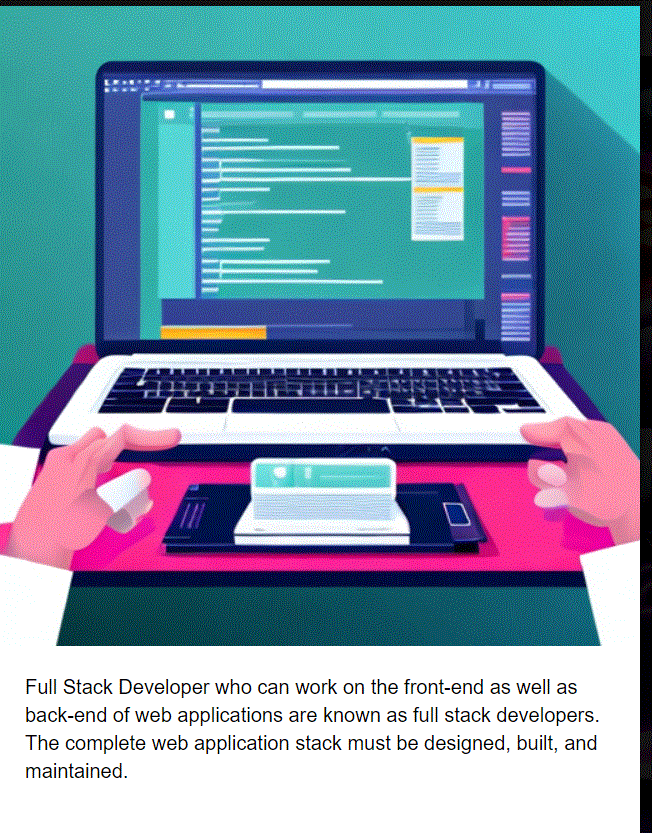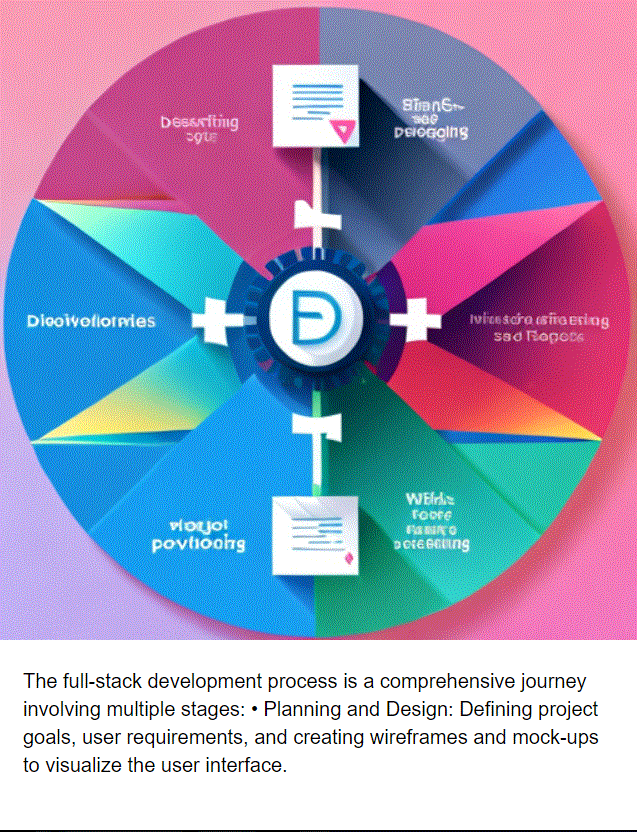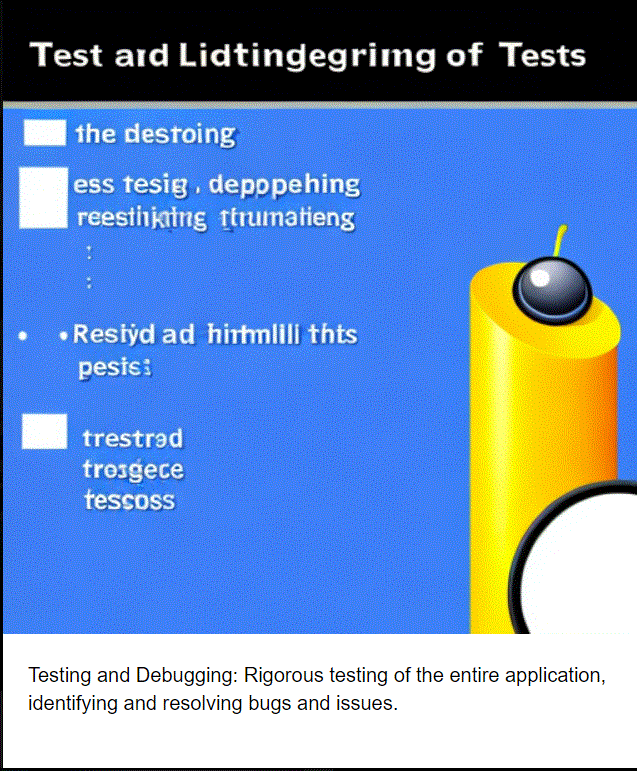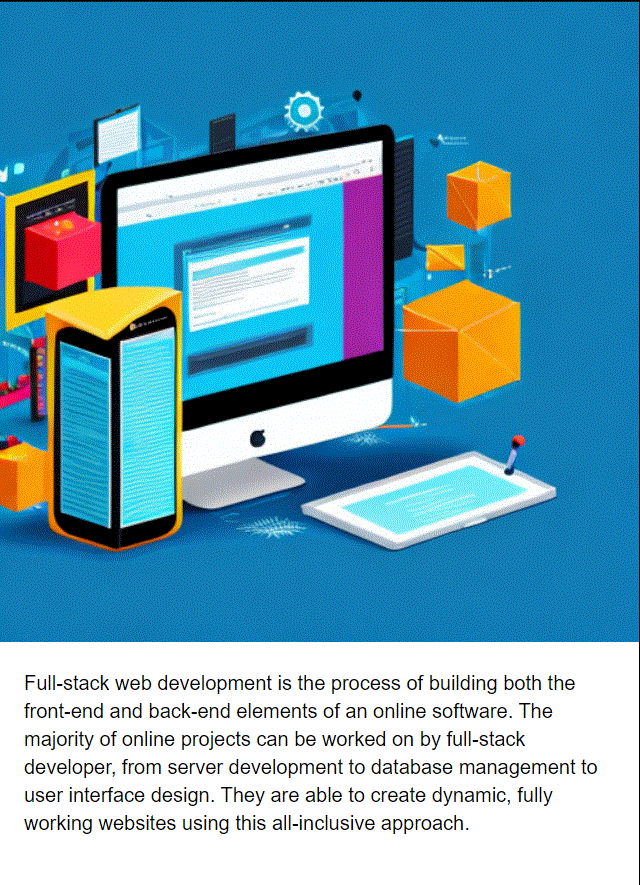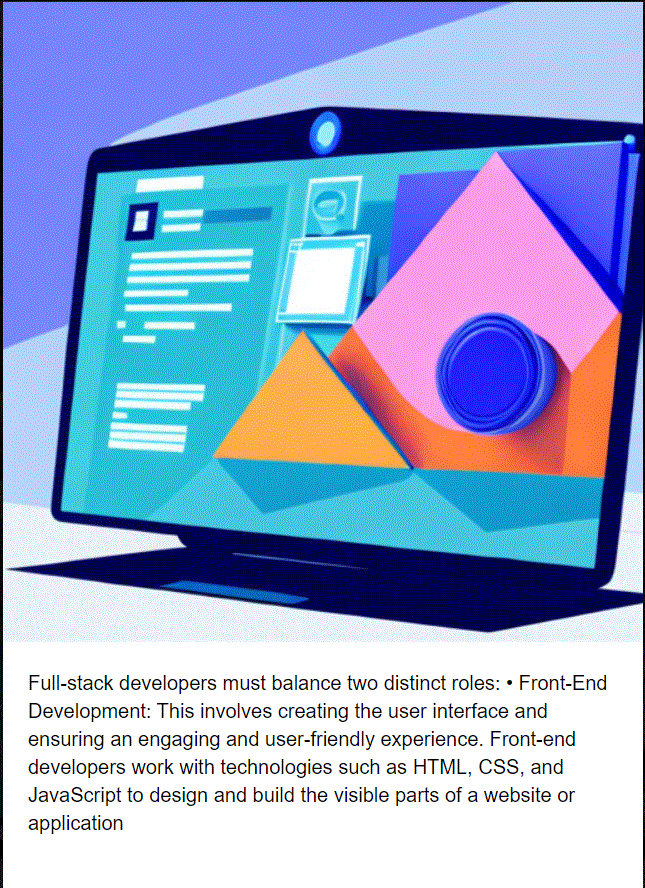

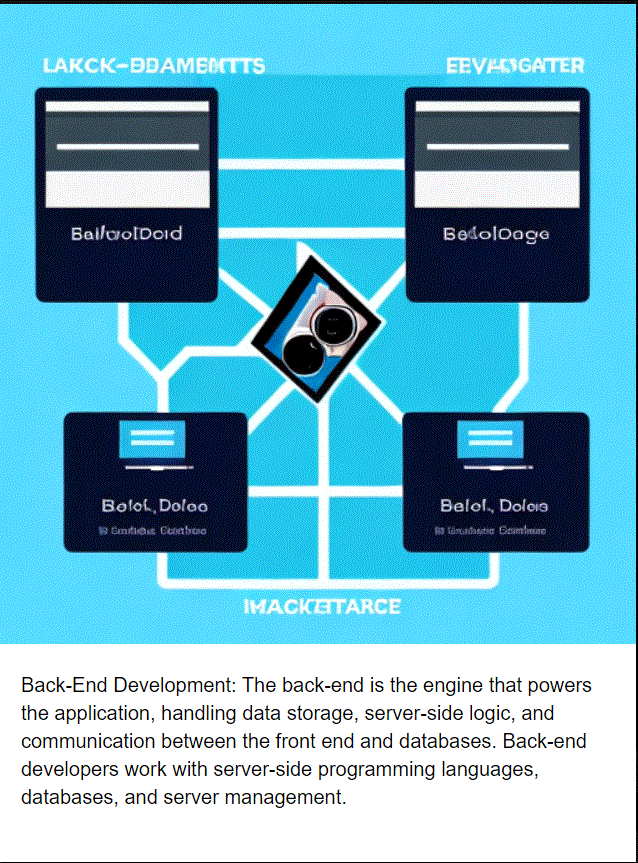

Web Development Course
Introduction
In the current digitally driven environment, web development has developed into a dynamic and diverse sector. Leading this movement is full-stack web development. This blog will go in-depth on the fascinating subject of full-stack web development, exposing its intricacies, exploring the skills needed, and underlining its expanding significance in the technological and commercial spheres.
What precisely is full-stack web development?
Full-stack web development is the process of building both the front-end and back-end elements of an online software. The majority of online projects can be worked on by full-stack developer, from server development to database management to user interface design. They are able to create dynamic, fully working websites using this all-inclusive approach.
Why Is Full-Stack Development Essential?
- The demand for full-stack developers has surged in recent years due to several compelling reasons:
. Efficiency: Full-stack developers can work on all aspects of a project, reducing the need for multiple specialists and streamlining the development process.
• Cost-Effectiveness: Hiring a full-stack developer can be more cost-effective for smaller businesses and startups compared to assembling a large development team.
• Problem-Solving: Full-stack developers have a comprehensive view of the project, making it easier to diagnose and resolve issues that may arise during development.
• Flexibility: In a rapidly evolving tech landscape, full-stack developers can adapt to different project requirements and technologies, offering versatility to organizations.
The Dual Role: Front-End vs. Back-End
Full-stack developers must balance two distinct roles:
• Front-End Development: This involves creating the user interface and ensuring an engaging and user-friendly experience. Front-end developers work with technologies such as HTML, CSS, and JavaScript to design and build the visible parts of a website or application.
• Back-End Development: The back-end is the engine that powers the application, handling data storage, server-side logic, and communication between the front end and databases. Back-end developers work with server-side programming languages, databases, and server management.
The Full-Stack Skill Set
A full-stack developer’s skill set is multifaceted, covering a wide range of technologies and tools. Some of the key components include:
• Programming Languages: Full-stack developers are proficient in languages like JavaScript, Python, Ruby, Java, or PHP for back-end development and scripting.
• Front-End Technologies: Mastery of front-end technologies such as HTML, CSS, JavaScript, and popular front-end frameworks like React, Angular, or Vue.js.
• Back-End Technologies: Knowledge of back-end frameworks like Node.js, Ruby on Rails, Django, Express.js, or Laravel, depending on the chosen programming language.
• Databases and Storage: Competency in working with databases, including relational databases like MySQL, PostgreSQL, or NoSQL databases like MongoDB.
• Version Control Systems: Familiarity with version control systems like Git to track changes and collaborate effectively with a team.
• APIs (Application Programming Interfaces): Understanding APIs and how to integrate them into web applications for functionalities like third-party services and data retrieval.
The Full-Stack Development Process
The full-stack development process is a comprehensive journey involving multiple stages:
• Planning and Design: Defining project goals, user requirements, and creating wireframes and mock-ups to visualize the user interface.
• Front-End Development: Building the user interface, ensuring responsive design, and implementing user interactions using HTML, CSS, and JavaScript.
• Back-End Development: Developing server-side logic, setting up the server, and creating APIs for data communication.
• Database Design and Integration: Designing the database schema, establishing connections to the database, and implementing data storage and retrieval mechanisms.
• Testing and Debugging: Rigorous testing of the entire application, identifying and resolving bugs and issues.
• Deployment and Maintenance: Deploying the application to a production server, monitoring its performance, and providing ongoing maintenance and updates.
Tools and Frameworks for Full-Stack Development
Full-stack developers often rely on various tools and frameworks to streamline their work. Some popular choices include:
• Front-End Frameworks: Frameworks like React, Angular, or Vue.js help developers create interactive and responsive user interfaces efficiently.
• Back-End Frameworks: Frameworks such as Express.js, Ruby on Rails, and Django provide a structured foundation for building server-side components.
• Integrated Development Environments (IDEs): IDEs like Visual Studio Code, WebStorm, or PyCharm offer robust code editing and debugging capabilities for efficient development.
The Challenges and Rewards of Full-Stack Development
Full-stack development presents both challenges and rewards:
• Complexity and Continuous Learning: Full-stack development can be complex and demanding, requiring developers to stay updated with evolving technologies. However, this continuous learning also keeps the profession stimulating and rewarding.
• Career Opportunities and Flexibility: Full-stack developers are highly sought after, with abundant career opportunities in a variety of industries. Their versatility allows them to work on diverse projects.
• Creating End-to-End Solutions: Full-stack developers have the unique ability to create end-to-end solutions, from conceptualization to deployment, giving them a sense of ownership over their projects.
Becoming a Full-Stack Developer
Full-stack web development is a challenging and rewarding career path. Full-stack developers are in high demand and are typically paid well. If you are interested in becoming a full-stack web developer.
Full-Stack Web Development In 7 days E-book
Are you looking to break into the exciting world of web development but don’t know where to start? Look no further than “Full-Stack Web Development In 7 days”!
This comprehensive guide will take you from beginner to full-stack web developer in just one week. With easy-to-follow instructions, you’ll learn everything you need to know about HTML, CSS, JavaScript, and back-end programming languages like Python and Ruby on Rails.
Not only will you learn the technical skills needed to create stunning web applications, but you’ll also gain a deep understanding of web development best practices and the latest trends in the industry.
Get Full-Stack Web Development E-Book by Clicking the below link..
Click Here
Click Here
FAQs
Full-stack web development is what?
Full-stack web development involves working on both the front-end and back-end aspects of web application. Full-stack developers are responsible for creating and maintaining all parts of web application.
What advantages do full-stack developers have?
Significant asset to any company, full-stack developers are in high demand. They are able to work on any facet of web project and have thorough understanding of how each component interacts with the others. This may result in quicker product development timelines, better quality goods, and resource usage that is more effective.
What skills do I need to be a full-stack developer?
Front-end development skills: HTML, CSS, JavaScript, and frameworks like React, Angular, and Vue.js.
Back-end development skills: Programming languages like Python, Java, Ruby, and PHP, as well as frameworks like Django, Rails, and Laravel.
Database skills: SQL and NoSQL databases.
Cloud computing skills: AWS, Azure, or Google Cloud Platform.
DevOps skills: Version control, continuous integration, and continuous delivery.
What are some popular full-stack development tools and frameworks?
Front-end: React, Angular, Vue.js, React Native, Flutter.
Back-end: Python, Java, Ruby, PHP, Django, Rails, Laravel.
Databases: MySQL, PostgreSQL, MongoDB, Redis.
Cloud computing: AWS, Azure, Google Cloud Platform.
DevOps: Git, GitHub, Jenkins, Docker, Kubernetes.
What are some common challenges that full-stack developers face?
Some common challenges that full-stack developers face
Keeping up with the latest technologies: The field of web development is constantly evolving, so it can be difficult to keep up with the latest technologies.
Dealing with complex problems: Full-stack developers often have to work on complex problems that require them to use a variety of skills and knowledge.
Managing multiple projects: Full-stack developers often have to manage multiple projects at the same time, which can be challenging.
What is the job outlook for full-stack developers?
The job outlook for full-stack developers is excellent. The Bureau of Labor Statistics projects that employment of web developers will grow 13% from 2020 to 2030, much faster than the average for all occupations.
What are some of the highest-paying full-stack web development jobs?
Full-stack software engineer
Senior software engineer
Staff software engineer
Lead software engineer
Director of engineering
What are some of the best companies to work for as a full-stack developer?
Amazon
Microsoft
Apple
Netflix
Airbnb
Uber
Spotify
Get Full-Stack Web Development E-Book by Clicking the below link..
Click Here
Click Here
